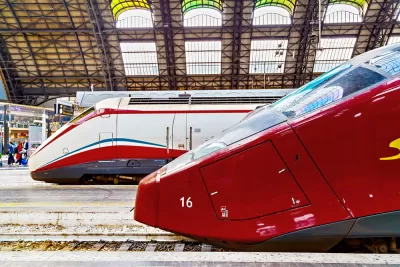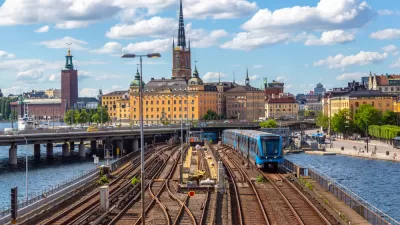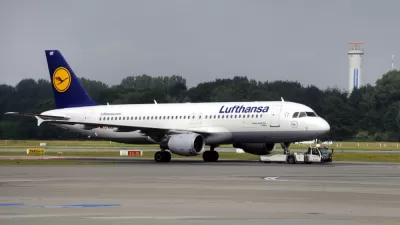European countries are committing to making intercity rail the preferable option compared to domestic and intra-continental flights. The shift seems to be working in Italy.

Over two thirds of people traveling between Roma and Milan take the train, with the number of passengers on the route (the main business route in Italy) quadrupling over the past decade. The trend in Italy reflects a broader cultural movement in Europe and achieves the desired effect of specific policy efforts of countries like Germany and France.
An article by Julia Buckley speculates about whether the success of intercity rail in Italy contributed to the demise of Alitalia—the national airline is shutting down business today.
According to the article, Alitalia tended to focus on domestic flights, so it "was a bird with its wings very much clipped from the start." The article mostly credits the demise of the airline on the market, not public policy. According to sources cited in the article, a "cocktail" of low-cost airlines and high-speed trains proved too much competition for the airline. On the rail side, there are now two high-speed rail companies (one public, Trenitalia, and one private, Nuovo Trasporto Viaggiatori) to choose from, and the rail infrastructure of the country is dramatically improved from the country's past.
According to Buckley's sources, tourists and Italians alike find the trains easier, cheaper, and quicker than flying. The consequences of this shift have spread to other sectors of the economy as well. "While real estate prices in Milan dipped 20.5% from 2008 to 2018, prices for offices around the high-speed stations of Rogoredo and Porta Garibaldi were up around 10%," according to Buckley.
FULL STORY: How Italy's high-speed trains helped kill Alitalia

Maui's Vacation Rental Debate Turns Ugly
Verbal attacks, misinformation campaigns and fistfights plague a high-stakes debate to convert thousands of vacation rentals into long-term housing.

Planetizen Federal Action Tracker
A weekly monitor of how Trump’s orders and actions are impacting planners and planning in America.

San Francisco Suspends Traffic Calming Amidst Record Deaths
Citing “a challenging fiscal landscape,” the city will cease the program on the heels of 42 traffic deaths, including 24 pedestrians.

Defunct Pittsburgh Power Plant to Become Residential Tower
A decommissioned steam heat plant will be redeveloped into almost 100 affordable housing units.

Trump Prompts Restructuring of Transportation Research Board in “Unprecedented Overreach”
The TRB has eliminated more than half of its committees including those focused on climate, equity, and cities.

Amtrak Rolls Out New Orleans to Alabama “Mardi Gras” Train
The new service will operate morning and evening departures between Mobile and New Orleans.
Urban Design for Planners 1: Software Tools
This six-course series explores essential urban design concepts using open source software and equips planners with the tools they need to participate fully in the urban design process.
Planning for Universal Design
Learn the tools for implementing Universal Design in planning regulations.
Heyer Gruel & Associates PA
JM Goldson LLC
Custer County Colorado
City of Camden Redevelopment Agency
City of Astoria
Transportation Research & Education Center (TREC) at Portland State University
Jefferson Parish Government
Camden Redevelopment Agency
City of Claremont





























